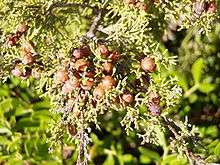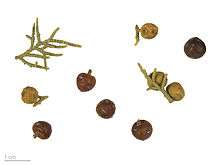Juniperus phoenicea
| Juniperus phoenicea | |
|---|---|
 | |
| Scientific classification | |
| Kingdom: | Plantae |
| Division: | Pinophyta |
| Class: | Pinopsida |
| Order: | Pinales |
| Family: | Cupressaceae |
| Genus: | Juniperus |
| Species: | J. phoenicea |
| Binomial name | |
| Juniperus phoenicea L. | |
 | |
| Natural range | |

Juniperus phoenicea, the Phoenicean juniper or Arâr,[1] is a juniper found throughout the Mediterranean region, from Morocco and Portugal east to Italy, Turkey and Egypt, south on the mountains of Lebanon, Israel, Jordan, and in western Saudi Arabia near the Red Sea, and also on Madeira and the Canary Islands. It mostly grows at low altitudes close to the coast, but reaches 2,400 metres (7,900 ft) altitude in the south of its range in the Atlas Mountains. It is the vegetable symbol of the island of El Hierro.[2]
Description
Juniperus phoenicea is a large shrub or small tree reaching 2–12 metres (6.6–39.4 ft) tall, with a trunk up to 1 metre (3.3 ft) diameter and a rounded or irregular crown. The leaves are of two forms, juvenile needle-like leaves 8–10 mm long on seedlings, and adult scale-leaves 0.5–2 mm long on older plants; they are arranged in opposite decussate pairs or whorls of three. It is largely monoecious, but some individual plants are dioecious. The cones are berry-like, 6–14 mm in diameter, orange-brown, occasionally with a pinkish waxy bloom, and contain 3-8 seeds; they are mature in about 18 months. The male cones are 2–4 mm long, and shed their pollen in early spring.
Varieties
There are two varieties, treated as subspecies by some authors:
- Juniperus phoenicea var. phoenicea. Throughout the range of the species. Cones globose, about as wide as long.
- Juniperus phoenicea var. turbinata (syn. J. turbinata). Confined to coastal sand dune habitats. Cones oval, narrower than long.
Uses
The tree's essential oil is especially rich in the tricyclic sesquiterpene thujopsene; the heartwood contains an estimated 2.2% of this hydrocarbon. The biochemist Jarl Runeburg noted in 1960 that "Juniperus phoenicea appears to be the most convenient source of thujopsene so far encountered."[3]
See also
References
- ↑ ambiguous arabic name also given to Tetraclinis articulata
- ↑ Ley 7/1991, de 30 de abril, de símbolos de la naturaleza para las Islas Canarias
- ↑ Runeburg, Jarl; Gramstad, Thor; Larsson, Lennart; Dodson, R. M. (1960). "The Chemistry of the Natural Order Cupressales XXXI. Constituents of Juniperus phoenicea L.". Acta Chemica Scandinavica. 14: 1995–1998. doi:10.3891/acta.chem.scand.14-1995.
General references – links
| Wikimedia Commons has media related to Juniperus phoenicea. |
- Conifer Specialist Group (1998). "Juniperus phoenicea". IUCN Red List of Threatened Species. Version 2006. International Union for Conservation of Nature. Retrieved 28 July 2006.
- Adams, R. P. Junipers of the World: The genus Juniperus. Victoria: Trafford, 2004. ISBN 1-4120-4250-X
- Gymnosperm Database: Juniperus phoenicea
- Zsolt Debreczy; Istvan Racz (2012). Kathy Musial, ed. Conifers Around the World (1st ed.). DendroPress. p. 1089. ISBN 9632190610.
